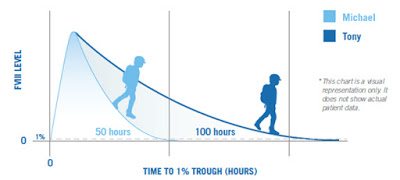Learn about factor treatment, an established option in hemophilia
Since 1990, we’ve been educating the hemophilia community about choice of therapies. Please read about coagulation, half-life, and a type of hemophilia treatment.
For people with hemophilia, factor treatment temporarily replaces missing factors (proteins) in your body.1 Factor treatment helps to control a bleed by producing a proper blood clot when you need it, and where you need it.1-6 It does so by following the natural balance of on-and-off steps in the blood clotting process.2,7-9 You can compare the on-and-off steps to the way a light switch turns on and off.
Before a bleed occurs, the factor activity remains “off,” ready but waiting until it is needed.10 Once there is a bleed, the blood clotting process is turned “on,” like a light switch, and factor is activated.2,8 After factor is activated, it can help stop a bleed in 3 tailored ways: when the bleed occurs, at the site of the bleed (where), and (how much) in an amount needed to control the bleed.2-4,9,11 After the bleed is controlled, the blood clotting process is turned off, factor is inactivated again, and the unused factor is eliminated from the blood.2,12
Factor treatment can be used in multiple scenarios to meet different treatment needs. Because factor is infused intravenously (IV), the proteins for clotting are immediately available for use, allowing for bleed protection when you need it.13
- Prophylaxis treatment is the routine infusion of factor with the goal of preventing bleeding episodes before they happen.1
- On-demand treatment is infused to control bleeds once they begin.1
- Factor can also be used to help prevent and manage bleeds during or after surgery.14
Keep in mind that every person with hemophilia is different. You and another person with hemophilia who are the same age and weight may require different amounts of factor—depending on how your bodies use factor. Your healthcare provider can individualize your treatment regimen by adjusting your infusion dose and frequency, based on how your body uses factor, your activity level, and lifestyle needs.15,16
Healthcare providers can reliably measure factor levels in your blood. Doing so can help individualize your treatment and help minimize bleeding risk.15,16 Talk with your healthcare provider to learn more.
Your lifestyle and activities can have an impact on your bleeding risk.16 Use of factor over the years has shown benefits in managing, controlling, and reducing bleeds.17,18 It is proposed that all bleeding, even bleeding you may not readily feel or see (subclinical or micro-bleeding), can result in significant damage to joint and bone health.19,20
For over 50 years, healthcare providers and patients like you have continued to rely on factor treatment.18 With substantial bleed-reduction benefits and experience in over 170 clinical trials, factor treatment is considered a well-studied and established treatment option.16,17,21
Shire has been dedicated to pursuing advancements in hemophilia for more than 60 years. As a leader and innovator in hemophilia research, we offer a vast array of patient programs and support—all of which are proudly brought to you by our dedicated people.
Explore the Possibilities. Talk to your healthcare provider to learn more about factor treatment.
To learn more about treating hemophilia, you can visit: http://www.bleedingdisorders.com/bleeding-disorders-info/ http://www.hemophilia.org
http://www.wfh.org
http://www.hemophiliafed.org
References
1. Peyvandi F, Garagiola I, Young G. The past and future of haemophilia: diagnosis, treatments, and its complications. Lancet. 2016;388:187-197.
2. Johari V, Loke C. Brief overview of the coagulation cascade. Dis Mon. 2012;58:421-423.
3. Gale AJ. Current understanding of hemostasis. Toxicol Pathol. 2011;39(1):273-280.
4. Stavenuiter F, Bouwens EAM, Mosnier LO. Down-regulation of the clotting cascade by the protein C pathway. Hematol Educ. 2013;7(1):365-374.
5. Antovic A, Mikovic D, Elezovic I, Zabczyk M, Hutenby K, Antovic JP. Improvement of fibrin clot structure after factor VIII injection in haemophilia A patients treated on demand. Thromb Haemost. 2014;111(4):656-661.
6. Hvas AM, Sørensen HT, Norengaard L, Christiansen K, Ingerslev J, Sørensen B. Tranexamic acid combined with recombinant factor VIII increases clot resistance to accelerated fibrinolysis in severe hemophilia A. J Thromb Haemost. 2007;5:2408-2414.
7. Lenting PJ, van Mourik JA, Mertens K. The life cycle of coagulation factor VIII in view of its structure and function. Blood. 1998;92(11):3983-3996.
8. Berg JM, Tymoczko JL, Stryer L. Many enzymes are activated by specific proteolytic cleavage. In: Biochemistry. 5th ed. New York, NY: WH Freeman; 2002.
9. Hoffman M, Monroe DM. A cell-based model of hemostasis. Thromb Haemost. 2001;85:958-965.
10. World Federation of Hemophilia. The clotting process. https://www.wfh.org/en/page.aspx?pid=635. Accessed September 5, 2017.
11. Colvin BT. Physiology of haemostasis. Vox Sanguinis. 2004;87(suppl 1):S43-S46.
12. Orlova NA, Kovnir SV, Vorobiev II, Gabibov AG, Vorobiev AI. Blood clotting factor VIII: from evolution to therapy. Acta Naturae. 2013;5(12):19-39.
13. Canadian Hemophilia Society. Factor replacement therapy. http://www.hemophilia.ca/en/bleeding-disorders/hemophilia-a-and-b/ the-treatment-of-hemophilia/factor-replacement-therapy/. Accessed September 20, 2017.
14. World Federation of Hemophilia. Guidelines for the management of hemophilia, 2nd ed. World Federation of Hemophilia, Montreal, Quebec, 2012.
15. Castellone DD, Adcock DM. Factor VIII activity and inhibitor assays in the diagnosis and treatment of hemophilia A. Semin Thromb Hemost. 2017;43(3):320-330.
16. Valentino LA. Considerations in individualizing prophylaxis in patients with haemophilia A. Haemophilia. 2014;20:607-615.
17. Franchini M, Mannucci PM. The history of hemophilia. Semin Thromb Hemost. 2014;40:571-576.
18. Center for Biologics Evaluation and Research. User fee billable biologic products and potencies approved under Section 351 of the PHS Act. http://www.fda.gov/AboutFDA/CentersOffices/ OfficeofMedicalProductsandTobacco/CBER/ucm122936.htm. Accessed September 20, 2017.
19. Manco-Johnson MJ, Abshire TC, Shapiro AD, et al. Prophylaxis versus episodic treatment to prevent joint disease in boys with severe hemophilia. N Engl J Med. 2007;357(6):535-544.
20. DiMinno MND, et al. Magnetic resonance imaging and ultrasound evaluation of “healthy” joints in young subjects with severe haemophilia A. Haemophilia. 2013;19:e167-e173.
21. NIH Clinical Trials Registry. Ongoing and complete clinical trials using factor in patients with hemophilia. https://clinicaltrials.gov/ct2/results/details?term=Factor+VIII&recr=Closed&fund=2. Accessed September 20, 2017.
©2017 Shire US Inc., Lexington, MA 02421.
All rights reserved. 1-800-828-2088.
SHIRE and the Shire Logo are registered trademarks of Shire Pharmaceutical Holdings Ireland Limited or its affiliates. S35567 10/17




